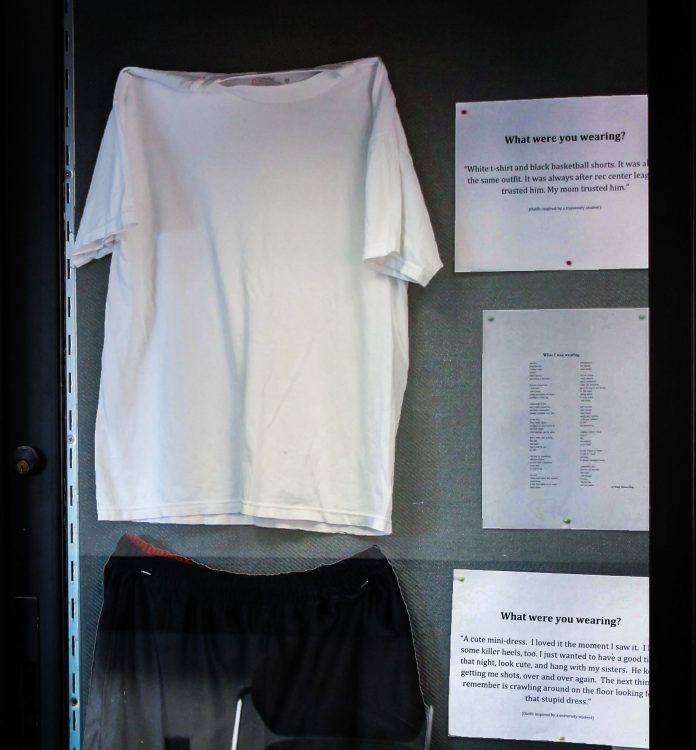
Andi Stevens
Special to the Ledger
On the third floor where LIB and OCB connect are eight common outfits pinned to the walls inside a glass display case. Articles of clothing included in the display are t-shirts, jeans, khakis, basketball shorts and sandals.
All outfits are inspired by victims of sexual assault who shared their stories with the Sexual assault art installation called “What were you wearing?”.
The objective of the installation is to question sexual assault myths, victim blaming, along with visual art. Placing the outfits on display educates people on the role stereotypes, gender and clothing play in sexual assault crimes.
Mary Simmerling, Assistant Professor of Research Integrity in Medicine at Weil Cornell Medical College, wrote a poem titled, “What I was Wearing.” Simmerling chose the title based on people consistently questioning her choice of outfit when she was sexually assaulted. Individuals appeared to be seeking her validation of consent by judging Simmerling’s attire.
In 2013, Simmerling’s poem was given to guests of a conference held by the Arkansas Coalition Against Sexual Assault. Jen Brockman, Sexual Assault Prevention and Education Center director for Kansas University, attended the conference at the same time Dr. Wyandt-Hiebert, Director of STAR at the University of Arkansas.
Brockman and Wyandt-Hiebert collaborated to express Simmerling’s poem through described clothing worn by survivors of sexual assault. Brockman and Wyandt-Hiebert received permission to use Simmerlings poem for the installation in 2013.
The first installation was exhibited on March 31-April 4, 2014, at the University of Arkansas. April is Sexual Assault Awareness month and the organizers intentionally correlated the opening.
Campuses throughout the United States have supported exhibiting the installation. Guests, students, and those involved have reported positive reactions.
“[The exhibit] has been either requested or, in some cases, already staged, at 225 entities on six continents, and that is just in the last seven months alone,” Brockman said.
“We wanted students, or anyone, to walk into the show and to see themselves reflected in the outfits … and put the blame where it belongs, which is on the person who’s caused the harm,” Brockman said. “We’re hoping students can see that this narrative they’re fed — that someone’s clothing causes sexual violence — is false.”
Survivor stories placed on small white paper plaques are next to the outfits. University student is where an author’s name would be.
Within the exhibit are content warnings stating,” the installation contains descriptions of gender-based violence,” and a number to contact for resources.
Some of the survivor’s stories read:
“A sun dress. Months later, my mother would stand in front of my closet and complain about how I never wore dresses anymore. I was six years old.”
“White t-shirt and black basketball shorts. It was always the same outfit. It was always after rec. center league. I trusted him. My mom trusted him.”
“T-shirt and jeans. It happened 3 times, by 3 different people in my life. Each time I was wearing a t-shirt and jeans.”
“Khakis and a dress shirt. I had to give a presentation that day in my communications class. They took my clothes at the hospital during my rape exam. I am not sure what happened to them.”
“It’s funny; no one has ever asked me that before. They ask me if being raped means I’m gay or if I fought back or how I could let this happen to me; but never about my clothes.”
Ted Reinhardt, student and student engagement ambassador, heard of the installation when it was at Kansas University. Feedback received from the exhibit was powerful and effective.
“This event crushes stereotypes,” Reinhardt said. “We decided to bring it to the college. Unfortunately, the exhibit only goes through April 12.”
Outfits in the exhibit come together with clothing donations and volunteers. Reinhardt participated within the group that constructed the installation.
“I had to use some of my own clothes for the exhibit.” Reinhardt said. “It made it more real for me.”
As a student ambassador, Reinhardt, is actively involved with student resources at the college. Reinhardt focuses on proactively reducing unsafe student situations and providing survivors with support through events held at the college.
“We just want to inform students because informed students prevent future incidents,” Reinhardt said.
Reinhardt will be graduating in the spring but is grateful for his experience with students and humanity.
“It’s good to make people uncomfortable because then we learn,” Reinhardt said.
Click here for more information.





















